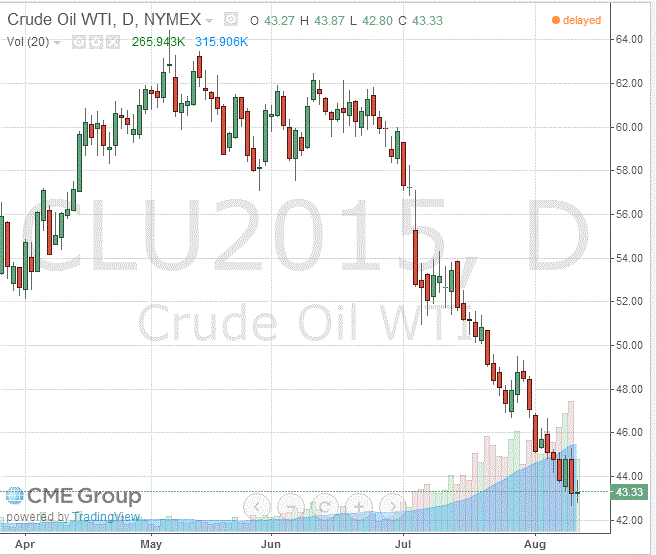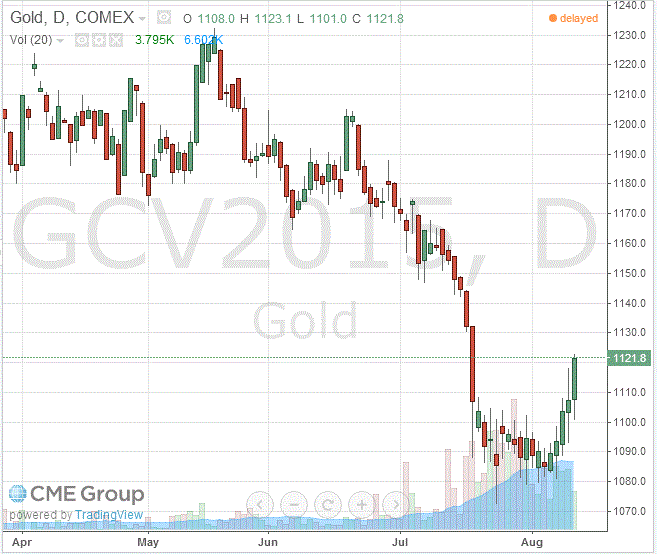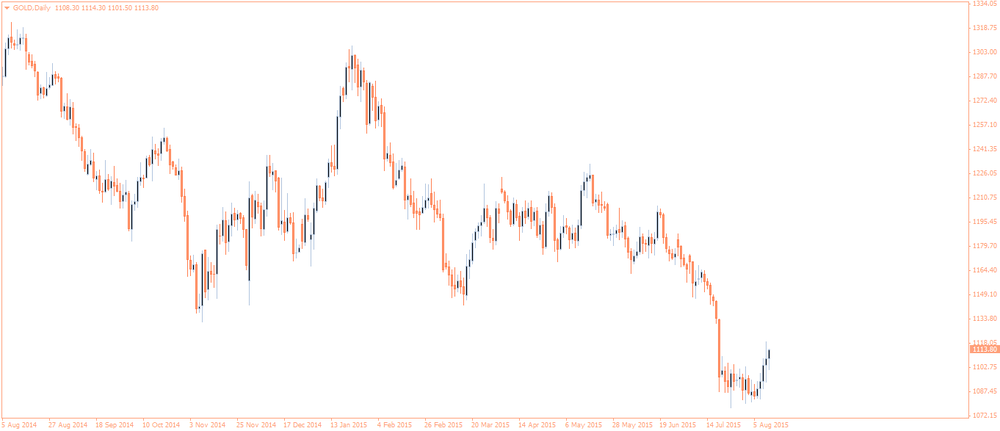Noticias del mercado
-
17:38
Oil prices increase on a weaker U.S. dollar and on the International Energy Agency report
Oil prices increased on a weaker U.S. dollar and on the International Energy Agency (IEA) report. The U.S. dollar dropped against other currencies on the further yuan devaluation. China's central bank set Wednesday's daily fixing at 6.3306 per U.S. dollar, down from 6.3231 on Tuesday.
The central bank said on Tuesday that it was a "one-off depreciation".
"Looking at the international and domestic economic situation, currently there is no basis for a sustained depreciation trend for the yuan," the central bank said on Wednesday.
A weaker yuan should help to boost the activity in the manufacturing sector and exports, which dropped 8.3% year-on-year in July.
The IEA released its monthly report on Wednesday. The agency upgraded its oil demand forecasts. The IEA expects global oil demand to expand by 1.6 million barrels a day this year, up by 200,000 barrels a day from its previous estimate.
Oil demand in 2016 is expected to be 1.4 million barrels a day.
The agency noted that oil oversupply will persist through 2016.
"While a rebalancing has clearly begun, the process is likely to be prolonged as a supply overhang is expected to persist through 2016 - suggesting global inventories will pile up further," the IEA said.
According to the IEA, low fuel prices lead to higher consumption.
Market participants also eyed the U.S. crude oil inventories data. U.S. crude inventories fell by 1.682 million barrels to 453.6 million in the week to August 07.
Analysts had expected U.S. crude oil inventories to decline by 2.00 million barrels.
Gasoline inventories fell by 1.3 million barrels to 57.1 million barrels last week, according to the EIA.
Crude stocks at the Cushing, Oklahoma, declined by 542,000 barrels.
U.S. crude oil imports increased by 393,000 barrels per day.
Oil production in the U.S. was down to 9.39 million barrels in last week from 9.47 million in the previous week.
Refineries in the U.S. were running at 96.1% of capacity.
WTI crude oil for September delivery climbed to $43.33 a barrel on the New York Mercantile Exchange.
Brent crude oil for September increased to $49.37 a barrel on ICE Futures Europe.
-
17:25
Gold rises as the U.S. dollar and stock markets dropped on the further yuan devaluation
Gold traded higher as the U.S. dollar and stock markets dropped on the further yuan devaluation. China's central bank set Wednesday's daily fixing at 6.3306 per U.S. dollar, down from 6.3231 on Tuesday.
The central bank said on Tuesday that it was a "one-off depreciation".
"Looking at the international and domestic economic situation, currently there is no basis for a sustained depreciation trend for the yuan," the central bank said on Wednesday.
A weaker yuan should help to boost the activity in the manufacturing sector and exports, which dropped 8.3% year-on-year in July.
The yuan devaluation could mean that the Fed will delay its interest rate hike.
Gold production in China climbed 8.0% year-over-year to 228.7 tons in the first six months of 2015. Gold consumption in China totalled 561.4 tons.
October futures for gold on the COMEX today rose to 1121.80 dollars per ounce.
-
16:57
U.S. crude inventories decline by 1.682 million barrels to 453.6 million in the week to August 07
The U.S. Energy Information Administration (EIA) released its crude oil inventories data on Wednesday. U.S. crude inventories fell by 1.682 million barrels to 453.6 million in the week to August 07.
Analysts had expected U.S. crude oil inventories to decline by 2.00 million barrels.
Gasoline inventories fell by 1.3 million barrels to 57.1 million barrels last week, according to the EIA.
Crude stocks at the Cushing, Oklahoma, declined by 542,000 barrels.
U.S. crude oil imports increased by 393,000 barrels per day.
Oil production in the U.S. was down to 9.39 million barrels in last week from 9.47 million in the previous week.
Refineries in the U.S. were running at 96.1% of capacity.
-
14:37
International Energy Agency upgrades its oil demand forecasts
The International Energy Agency (IEA) released its monthly report on Wednesday. The agency upgraded its oil demand forecasts. The IEA expects global oil demand to expand by 1.6 million barrels a day this year, up by 200,000 barrels a day from its previous estimate.
Oil demand in 2016 is expected to be 1.4 million barrels a day.
The agency noted that oil oversupply will persist through 2016.
"While a rebalancing has clearly begun, the process is likely to be prolonged as a supply overhang is expected to persist through 2016 - suggesting global inventories will pile up further," the IEA said.
According to the IEA, low fuel prices lead to higher consumption.
The agency also said that oil supply declined by nearly 600,000 barrels a day in July, driven by lower non-OPEC output.
Non-OPEC oil supply growth is expected to fall to 1.1 million barrels a day this year and by 200,000 barrels a day in 2016, while OPEC oil supply is expected to increase to 30.8 million barrels a day in 2016, up 1.4 million barrels a day from 2015.
-
10:44
The World Bank expects oil prices to decline by €10 per barrel next year due to the lift-off of sanctions on Iran
The World Bank said on Monday that the lift-off of sanctions on Iran will lower oil prices by €10 per barrel next year. The lift-off will also have an impact on Iran's economic growth and on Iran's trading partners like India, China and the U.K.
Iran's economy is expected to expand 5% in 2015, up from a 3% growth this year.
"Just as the tightening of sanctions in 2012 led to a sharp decline in Iran's oil exports and two years of negative growth, we expect the removal of sanctions to boost exports and revive the economy," World Bank Chief Economist for the Middle East and North Africa region, Shanta Devarajan, said.
-
10:39
The yuan devaluates 1.6% against the U.S. dollar
The People's Bank of China (PBoC) has devaluated the yuan for the second day. China's central bank set Wednesday's daily fixing at 6.3306 per U.S. dollar, down from 6.3231 on Tuesday.
The PBoC said on Tuesday that it was a "one-off depreciation".
"Looking at the international and domestic economic situation, currently there is no basis for a sustained depreciation trend for the yuan," the central bank said on Wednesday.
A weaker yuan should help to boost the activity in the manufacturing sector and exports, which dropped 8.3% year-on-year in July.
-
10:25
U.S. Treasury Department is cautious regarding the yuan devaluation
The U.S. Treasury Department is cautious regarding the yuan devaluation.
"While it is too early to judge the full implications of the change in the [People's Bank of China] reference rate, China has indicated that the changes announced today are another step in its move to a more market-determined exchange rate," a U.S. Treasury Department spokeswoman said.
The U.S. Treasury Department encourages further monetary policy changes in China.
-
10:13
International Monetary Fund (IMF): the yuan devaluation is “a welcome step”
The International Monetary Fund (IMF) said on Wednesday that the yuan devaluation was "a welcome step".
"Greater exchange rate flexibility is important for China as it strives to give market forces a decisive role in the economy and is rapidly integrating into global financial markets," the IMF statement said.
The IMF noted that China should "achieve an effectively floating exchange rate system within two to three years".
-
09:01
Oil prices slid further
West Texas Intermediate futures for September delivery declined to $43.06 (-0.05%), while Brent crude fell to $49.02 (-0.33%). On Wednesday the People's Bank of China allowed the yuan to fall further after it conducted 1.9% devaluation on Tuesday. These moves question health of the second-biggest economy in the world and thus raise doubts over demand for excessive crude, which OPEC members keep producing. The cartel also raised its forecast of oil supplies from non-member producers in 2015.
Analysts believe that China's government might intervene further in an attempt to stimulate growth and support industrial production.
-
08:42
Gold advanced
Gold climbed for the fifth session in a row. It reached $1,112.20 (+0.41%) after Tuesday's surprise 2% devaluation of the yuan hit equities around the globe. This morning the yuan fell further. However bullion's potential gains are limited by expectations of a rate increase in the U.S. in the coming months. Economists believe that China's currency devaluation is unlikely to cause the Fed give up its plans.
-
00:31
Commodities. Daily history for Aug 11’2015:
(raw materials / closing price /% change)
Oil 43.25 +0.39%
Gold 1,108.10 +0.04%
-


